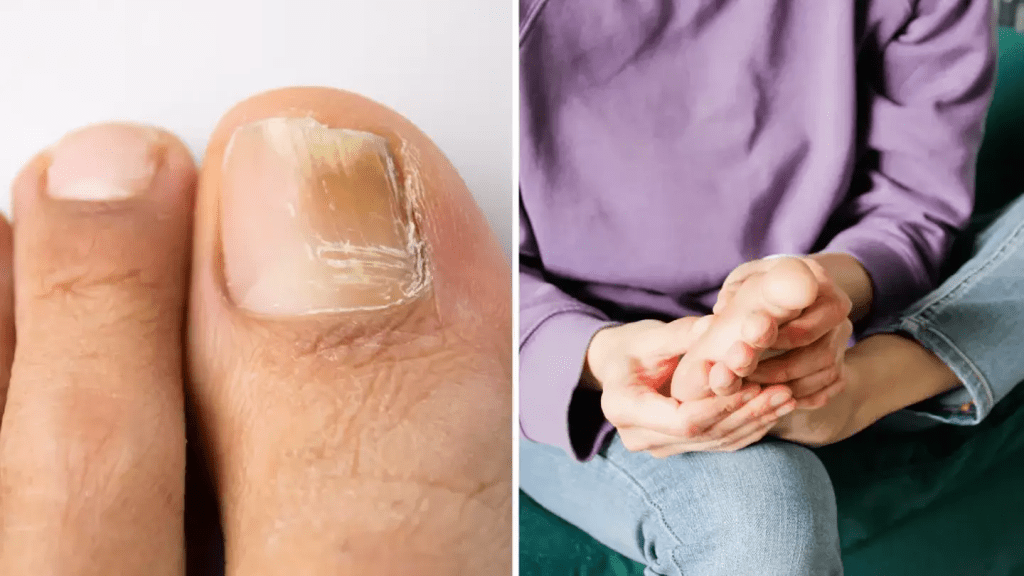Our bodies often provide subtle clues when something is wrong, and according to pharmacist Noel Wicks, your feet could be giving you critical signs of a potentially fatal condition: peripheral arterial disease (PAD). Recognizing these early warning signs could be the difference between addressing a serious health issue in time and facing more severe complications.
Here’s everything you need to know about PAD, how it can manifest through symptoms in your feet, and what you should do if you suspect you have this condition.

What Is Peripheral Arterial Disease (PAD)?
Peripheral arterial disease (PAD) is a common condition that occurs when fatty deposits build up in the arteries, restricting blood flow to the leg muscles and other areas of the body. This restricted blood supply can cause significant discomfort and pain in the legs and feet, but the implications of PAD extend far beyond these symptoms.
According to the NHS, PAD is linked to life-threatening conditions such as heart disease, stroke, and diabetes. Left untreated, PAD can lead to severe complications, including limb amputation in extreme cases.
How Do Your Feet Reveal PAD?
Pharmacist Noel Wicks explains that our feet can serve as a critical indicator of PAD, showing early signs before the condition worsens. Here are the two primary symptoms you should look for:
1. Cold or Painful Feet
One of the earliest signs of PAD is a noticeable change in how your feet feel. Cold, painful, swollen, or numb feet could indicate restricted blood flow. These symptoms may be particularly pronounced in the toes and can worsen over time if left untreated.
2. Changes in Your Toenails
Thick, brittle, or yellowing toenails may signal PAD. While these changes are often associated with fungal infections, Wicks notes that such infections could also be an underlying sign of PAD. Monitoring your toenail health is crucial, as it can reveal broader cardiovascular issues.
Other Warning Signs to Watch For
PAD can present itself through various symptoms, many of which affect the feet and legs. If you experience any of the following, it’s essential to consult a healthcare professional:
- Tingling or Burning Sensations: Persistent pain or tingling in the feet could signal nerve damage caused by restricted blood flow.
- Dry, Cracked Skin: Poor circulation can lead to excessively dry skin that may crack and bleed.
- Sores That Don’t Heal: Open wounds or ulcers on the feet that take a long time to heal—or don’t heal at all—are major red flags for PAD.
- Blisters or Swelling: These may occur due to poor blood flow, which compromises the skin’s ability to recover from minor injuries.
- Hair Loss or Skin Color Changes: Hair loss on the feet and legs or a noticeable change in skin color (such as becoming pale or bluish) could be signs of advanced PAD.

Your feet could be telling you that something is wrong (Predrag Popovski/Getty)
Who Is Most at Risk for PAD?
While PAD is more common in older adults, certain lifestyle factors and health conditions significantly increase the risk of developing this condition. According to the NHS, the following groups are most vulnerable:
- Smokers: Tobacco use greatly accelerates arterial damage, increasing the likelihood of PAD.
- Diabetics: People with type 1 or type 2 diabetes are at higher risk due to complications that affect blood vessels.
- Individuals with High Blood Pressure or Cholesterol: These conditions contribute to the build-up of fatty deposits in the arteries.
- Overweight or Inactive Individuals: Lack of physical activity and excess weight strain the cardiovascular system, compounding the risk of PAD.
Why Early Diagnosis Is Critical
PAD is often referred to as a “silent killer” because its symptoms may not appear until the condition has already caused significant arterial damage. If left untreated, PAD can result in severe consequences, including:
- Tissue Death: Restricted blood flow can cause tissue in the feet or legs to die, sometimes requiring amputation.
- Heart Attack or Stroke: PAD significantly increases the risk of cardiovascular events.
- Wasting Muscles: Prolonged PAD can lead to muscle atrophy in the legs, reducing mobility and quality of life.
When to See a Doctor
The NHS advises seeking medical attention if you experience recurring leg pain, particularly during exercise or physical activity. This type of pain, known as claudication, is a hallmark symptom of PAD and should never be ignored.
Additionally, consult your GP immediately if you notice any of the following:
- Persistent foot pain or coldness.
- Non-healing sores or ulcers on your feet or legs.
- Noticeable changes in skin color or hair loss on the legs.
As the saying goes, it’s better to be safe than sorry. Early intervention can make a significant difference in managing PAD and preventing life-threatening complications.

Untreated, PAD could lead to more serious illnesses (shurkin_son/Getty)
Preventing PAD Through Lifestyle Changes
While some risk factors for PAD, such as age and genetics, are beyond your control, making specific lifestyle changes can significantly reduce your risk:
1. Maintain a Healthy Diet
Adopt a diet rich in fruits, vegetables, whole grains, and lean proteins while minimizing processed foods and saturated fats. This will help reduce cholesterol levels and support overall cardiovascular health.
2. Stay Active
Regular exercise improves circulation and strengthens your heart. Aim for at least 30 minutes of moderate activity, such as walking, five times a week.
3. Quit Smoking
Smoking is one of the leading causes of arterial damage. Quitting smoking is one of the most effective ways to reduce your risk of PAD and improve your overall health.
4. Manage Chronic Conditions
If you have diabetes, high blood pressure, or high cholesterol, work closely with your healthcare provider to keep these conditions under control.
5. Monitor Your Feet Regularly
Inspect your feet and toenails for any changes, such as discoloration, swelling, or sores that don’t heal. Early detection can prevent complications.
Final Thoughts: Don’t Ignore Your Feet’s Warnings
Peripheral arterial disease is a serious condition that often goes unnoticed until it’s too late. Your feet, however, can provide valuable clues that something is wrong. From cold or painful sensations to changes in toenails, paying attention to these early warning signs can be lifesaving.
By adopting a proactive approach—regularly checking your feet, making healthy lifestyle choices, and seeking medical advice when needed—you can significantly reduce your risk of PAD and its potentially deadly complications.
Remember, it’s not just about your feet—it’s about protecting your overall health and well-being. If you’re ever in doubt, consult your GP. Your feet might just be telling you something you can’t afford to ignore.


